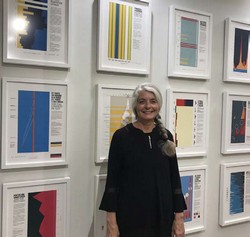An art exhibition titled “Just Beachy/After Sandy,” created by Karen Bright, MFA, a Professor of Art, and Amanda Stojanov, an Assistant Professor of Communication, is displayed in DiMattio Gallery located in Rechnitz Hall, where its opening reception took place at 6 p.m. on Friday, Sept. 20.
The exhibit is a public participatory art installment that highlights the effects of Hurricane Sandy and shares the stories of residents who were impacted. It consists of four parts: The Drying Station, Nine Feet High, The Climate Shelter, and The Transformer.
Bright was inspired to make something that would bring people together to share their stories. “I kept hearing Sandy story after Sandy story and I felt that it was kind of forgotten on the national stage, and I felt that people had a lot to talk about even though it was 7 years ago.”
Bright explained that she personally had questions like, ‘Why didn’t we have more warning time?’ and ‘Did the full moon have anything to do with it?’ Her work has been environmentally themed since the 80s.
Bright’s “The Drying Station,” contains nearly a century of scientific data for natural phenomena such as high tide levels, wave heights, and wind speeds on the Jersey Shore. That information was interpreted and converted to graphics on beach towels, representative of measurements.
For example, one graph focused on Atlantic City’s expected inundation versus the actual flooding that occurred during Sandy. In another beach towel, Bright looked at 86 years of tidal activity at Sandy Hook and created a map.
For each beach towel, Bright was looking to create a tangible piece of art where climate change was evident. She explained, “I was able to research enough of the available data and translate that into graphics, a more painterly version of it.”
Another exhibit was “The Climate Shelter” a concept conceived by both Bright and Stojanov. Visitors can step into the geodesic-domed shelter to hear and view a digital media interpretation called “Hurricane.”
Through a sequence of high winds, wave intensity, transformer eplosions, and rain, the animation seeks to capture the essense of the the storm
Stojanov said, “My expertise is digital media, so this is an interactive exhibit in that the code is written in such a way that it’s reacting to the sound files and as it’s reading frequencies the visuals change.”
Alexis Garry, a health studies student, explained that the exhibit is an extension of the climate crisis teach in, where the impacts of Sandy are seen, and the public can play a interactive role in the exhibit by telling their stories. .
“I feel like some students don’t tell their stories about Sandy and Karen Bright is giving students the opportunity to. There’s sheet of paper where people can write down their experience and pin it to the piece of art, so they become the art in a way,” she said.
PHOTO TAKEN by Megan Ruggles


